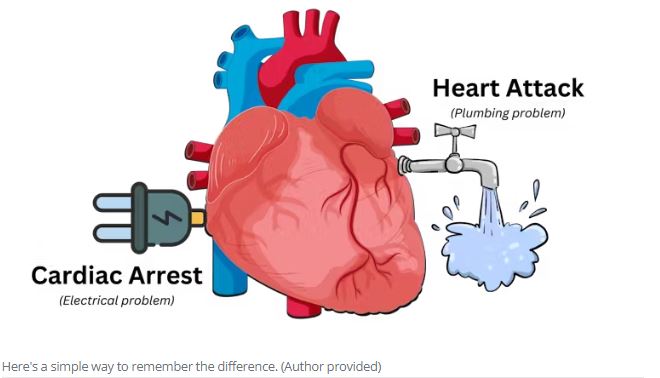Perth: In July 2023, 18-year-old basketball star Bronny James, son of NBA legend LeBron James, collapsed on the court and was hospitalized after suffering a cardiac arrest. While many reports inaccurately referred to the incident as a heart attack, the terms cardiac arrest and heart attack are often mistakenly used interchangeably, despite being distinct conditions. According to The Cardiac Society of Australia and New Zealand (ANZ), a cardiac arrest occurs when the heart suddenly stops beating due to an electrical malfunction, while a heart attack happens when blood flow to the heart is blocked. Understanding this difference is crucial for proper medical response and awareness. Photo Courtesy: Getty Images
How the Heart Works
The heart is a muscle that pumps blood, carrying oxygen and nutrients throughout the body. This process relies on a steady blood supply from the coronary arteries. If these arteries become blocked, the heart muscle may suffer damage due to lack of blood flow, impairing its function.
Heart Attack vs. Cardiac Arrest
A heart attack, or myocardial infarction, occurs when part of the heart muscle is damaged or dies due to a blockage in the coronary arteries. This blockage often results from a buildup of fatty deposits, known as atherosclerosis. Risk factors include high blood pressure, high cholesterol, poor diet, diabetes, stress, and genetics. Other causes can include coronary artery spasms or trauma.

In contrast, a cardiac arrest, or sudden cardiac arrest, happens when the heart suddenly stops beating effectively. This is usually due to electrical malfunctions within the heart, which can disrupt the heart’s rhythm.
There are several types of arrhythmias involved:
Ventricular Tachycardia: Rapid heart rate over 100 beats per minute, hindering the heart’s ability to pump blood.
Ventricular Fibrillation: Erratic, fast heartbeats exceeding 300 beats per minute, causing the heart to quiver.
Pulseless Electrical Activity: Electrical activity without a corresponding heartbeat or pulse.
Asystole: Flat-line heart rhythm, indicating no electrical activity.
Cardiac arrest can result from various causes, including drowning, trauma, asphyxia, electrical shock, and drug overdose. In James' case, it was linked to a congenital heart defect.
However, ischemic heart disease from heart attacks is the most common cause of cardiac arrest, accounting for 70% of cases.
Interconnection and Symptoms
A heart attack can lead to cardiac arrest if damaged heart tissue disrupts electrical signals, increasing the risk of arrhythmias. However, a cardiac arrest does not typically cause a heart attack.
Symptoms of cardiac arrest include sudden loss of consciousness, no pulse or heartbeat, stopped breathing, and bluish skin. Heart attack symptoms often involve chest pain or discomfort, potentially spreading to the arms, back, neck, jaw, or stomach, accompanied by shortness of breath, nausea, light-headedness, and sweating.
Key Takeaway
Though both conditions are heart-related, they differ in cause and effect. A heart attack resembles a blockage in plumbing, while cardiac arrest is akin to an electrical failure. Both require prompt medical intervention to address their potentially severe consequences.